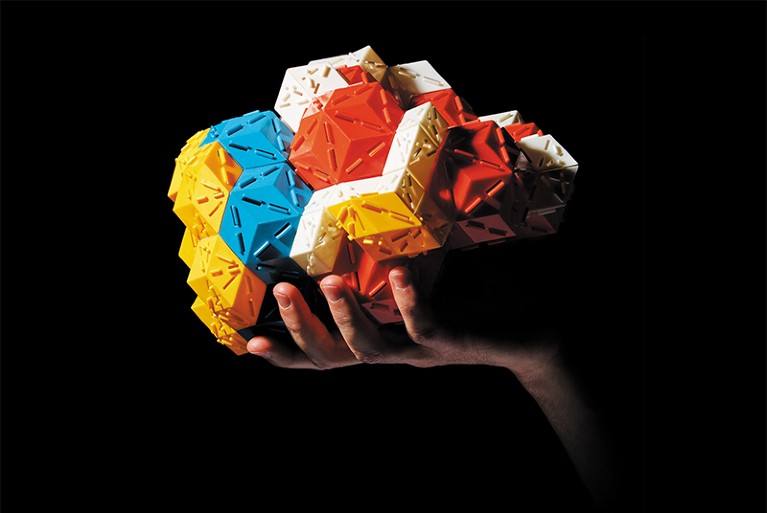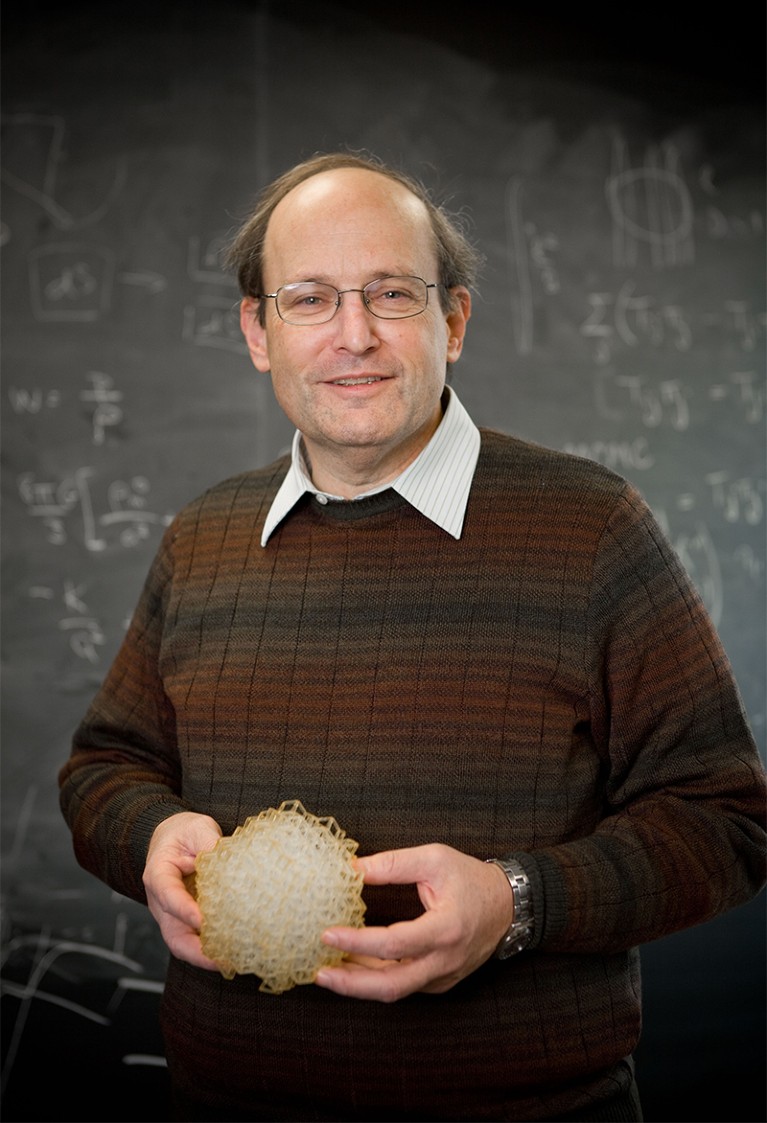
A model of a quasicrystal structure.Credit: Alison Forner/The Second Kind of Impossible, Simon and Schuster
The Second Kind of Impossible: The Extraordinary Quest for a New Form of Matter Paul J. Steinhardt Simon & Schuster (2018)
Picture this. In Russia’s far east, a motley crew of conspirators races against time to solve a mystery hidden for billions of years. The enigma could link a speck of rock found in the dusty basement of an Italian museum to the evolution of the Solar System. To solve it, a brilliant theoretical physicist must overcome impossible odds, Kremlin agents, a vanished package, secret diaries and a trek across a volcanic peninsula.
This is no Hollywood blockbuster: it is real-world scientific derring-do. In The Second Kind of Impossible, theoretical physicist Paul Steinhardt relates his bold quest to find a natural quasicrystal, a form of matter with an unusual arrangement of atoms thought impossible for a crystal. The result is a mix of sober, lab-bound scientific memoir and rollercoaster adventure, packed with discovery, disappointment, exhilaration and persistence.
In crystals, atoms are arranged in a repeating pattern. In quasicrystals, they are still ordered but the pattern is not periodic: it doesn’t repeat. This oddity results in unexpected rotational symmetries (different from, say, that of a square lattice, which repeats itself four times in a full rotation). Quasicrystals were first discovered in the 1980s, but the interpretations proffered for them were not accepted by many in the scientific community, bar physicists, for some time. After all, they upset nearly two centuries of scientific understanding about the structure of matter. French priest René-Just Haüy’s 1801 Treatise of Mineralogy established that solids contain microscopic building blocks and that all elements and mixtures thereof can, at least in principle, be found in crystal form, from sucrose to sapphire. Despite thousands of possible atomic arrangements, the rules to describe crystals were simple: the materials could have only two-, three-, four- or six-fold symmetry. Until quasicrystals’ discovery violated them.
Steinhardt’s story begins in Pasadena, California, in 1985. Then on the faculty at the University of Pennsylvania in Philadelphia, Steinhardt had given a talk at his undergraduate alma mater, the California Institute of Technology, where he explained to physicist Richard Feynman, his former professor, a theory that he had devised with doctoral student Dov Levine. This predicted the possibility of quasicrystals, with symmetries technically possible but extremely unlikely: the “second kind of impossible”.
Forbidden structure
Since the late 1970s, Steinhardt had imagined that ‘forbidden’ crystals with five-fold symmetry might be possible if, on cooling, atoms were arranged into a space-spanning network of icosahedra. He and Levine experimented first with styrofoam balls and pipe cleaners, and later with paper models. They looked to Penrose tilings, in which two shapes combine to create a non-repeating pattern, not unlike those seen in classical Islamic tiling. They realized that by drawing parallel lines on a Penrose tiling, they could prove that the tiles are arranged quasiperiodically, producing five-fold symmetry. This was the breakthrough they needed. The leap to three dimensions produced Steinhardt’s long-imagined icosahedral quasicrystal.

Paul Steinhardt with a quasicrystal model.Credit: Trustees of Princeton Univ.
Unknown to them, a couple of hundred kilometres away, a materials scientist had obtained a diffraction pattern unlike any he had seen before — for a rapidly cooled alloy of aluminium and manganese. The researcher was Dan Shechtman, and he was working at the National Bureau of Standards (now the National Institute of Standards and Technology) in Gaithersburg, Maryland. The diffraction pattern had ten-fold rotational symmetry. Astonished, Shechtman drew its concentric rings of ten dots in his lab book, writing “10-fold???” next to it. He didn’t know it yet, but he had just discovered the first quasicrystal. In 2011, he won the Nobel Prize in Chemistry for it.
Steinhardt and Levine, recognizing the collective implications, published a paper on their theory in Physical Review Letters, laying the foundations of the field of quasicrystal research (D. Levine and P. J. Steinhardt Phys. Rev. Lett. 53, 2477; 1984).
Hundreds of quasicrystals with different symmetries have now been made in the lab. Non-stick frying pans were among the first applications of quasicrystals, owing to the alloys’ low friction, high hardness and low surface reactivity. Steel hardened by small quasicrystal particles is used in needles for acupuncture and surgery, dental instruments and razor blades. Quasicrystals have been discovered in materials other than metals, including polymers and mixtures of nanoparticles. Computer simulations suggest that quasicrystals should be even more ubiquitous.
All these quasicrystals were human-made, but Steinhardt became curious about naturally occurring ones. In 1999, now on the faculty at Princeton University in New Jersey, he set out on a quest that few theoretical physicists could imagine — to find one. This is the true heart of his book.
Global hunt
Steinhardt started by looking to the past — in museums, which have huge collections of mineral samples from around the world. Perhaps, he surmised, one of these was a misidentified quasicrystal. He assembled a crack team of fellow hopefuls — including a geoscientist, an electron microscopist and an undergraduate — and the hunt began. Years of combing through dusty archives turned up nothing, until a box from the Museum of Natural History in Florence, Italy, arrived at Princeton containing a nearly invisible speck of a rare mineral, khatyrkite. On 2 January 2009, the researchers became certain that they had discovered a natural quasicrystal (later named icosahedrite). But where did it come from?
The sample, they deduced after many unexpected twists and turns, had probably been found on Russia’s remote, volcanic Kamchatka Peninsula. Steinhardt led an expedition there in 2011 — a wild scavenger hunt searching for the stream that the team thought contained the original source. The group ultimately worked out that the speck came from a meteorite that also contained a second natural quasicrystal, dubbed decagonite.
This book is a front-row seat to history as it is made. For quasicrystal aficionados like me, it is riveting. For anyone who has dreamt of finding a scientific needle in a haystack, it is exhilarating. Steinhardt strikes a balance between mathematical detail and accessibility. He captivates with vivid details about his wonder, frustrations and even a few moments of unleashed ego. We learn about the deep relationships and bold ideas that kept his journey on course.
This nail-biting narrative reminds us that the thrill of scientific discovery is not found in a single eureka moment. It is instead marked by determination, team work, optimism and, importantly, luck. Contemplating Julia 89, an asteroid orbiting the Sun between Mars and Jupiter that could be the source of the fateful meteorite, The Second Kind of Impossible ends as it begins — with the possibility of impossibility.

 Discovery of superconductivity in quasicrystal
Discovery of superconductivity in quasicrystal
 Impossible crystals snag chemistry Nobel
Impossible crystals snag chemistry Nobel



